 |
| Breakfast stop. |
 |
| Don't ask me what we were eating. I didn't like mine so much but it put something in the belly. |
 |
| And so convenient to the entrance of the subway we will be riding to get to the Acropolis |
 |
| Not a lot to see here. |
 |
| Double click to enlarge for reading |
 |
| Oh, the path is getting steeper. |
 |
| Stopping to rest and see how far we have climbed. |
 |
| Love this mock up of what the hillside looked like during the Classical period. It helps make sense of the ruins we are seeing. |
 |
| Time for a break to catch our breath and enjoy the view.... oh is that a rain storm coming our way? It ended up missing us. Whew! |
 |
| The Odeion of Herodes Atticus. |
 |
| Prettiest walking surface in the Acropolis area. |
 |
| Loved the look of the rock |
 |
| Still climbing and stumbling over some old structures. |
 |
| Here's a map to keep you oriented. The commentary below will follow the numbering. Double click to enlarge for reading. |
 |
| Finally we made it to the entrance |
 |
| West gates of the 3rd century fortifications. |
 |
| View beyond the gates. |
 |
| Time to continue the climb. |
 |
Temple of Athena Nike is on the right.
|
 |
| View of the temple from the other side. |
 |
| Nothing left to see of this structure. |
 |
| The foundation of the Old Temple is in front of this building, so not much to see there either. |
 |
| The pillars carved like women are reproductions. |

The Pandroseion, a sanctuary dedicated to Pandrosos, was founded north of the temple of Athena already in the Archaic Period. Pandrosos, the kind and obedient daughter of the legendary king of Athena, Kekrops, was the first priestess of Athena Polias, the patron goddess of the city.
The Pandroseion was founded in the area of the Acropolis where the oldest spots of the Athenians were preserved, such as the signs of the contest between Athena and Poseidon for the patronage of the city; the sacred olive tree, which grew when the goddess struck the rock with her spear, giving her the victory; the spring, which appeared when Poseidon struck his trident; and the tomb of Kekrops, who was the judge or a witness of the contest of the two gods, according to the myth.
The sacred olive tree of Athena was enclosed in the sanctuary of Pandrosos. Kekrops’ tomb was protected by a separate precinct wall at the southeast of the Pandroseion, whose form is unknown, was destructed by the Persians in 480 B.C.
Today, a few remains of the classical sanctuary are preserved at the west side of the Erechtheion,, as well as parts of the foundation of its north boundary. The foundation indicate that it was an open-air sanctuary of a trapezoidal plan. The entrance of the sanctuary was a small propylea located in the court under the sacred olive tree.
The Pandroseion underwent alterations when the Erechtheion was built on its east side (431-406 B.C. or 421-406 B.C.). Then, the entrance was through an undecorated door at the right of the elaborate entrance at the north of the Erechtheion, while the two sanctuaries were also directly connected by a door at the west wall of the Erechtheion. At that time, the court of the Erechtheion was paved and part of Kekrops’ tomb was integrated under the porch of the Erechtheion
The olive tree that exists in the sanctuary today was planted in the 20th century in memory of Athena’s sacred tree.















 |
| Ruins of the Temple of Rome and Augustus are just east of the Parthenon |
 |
| Viewing platform with the Greece flag. |
 |
| View of the buildings atop the Acropolis from the viewing platform. |
 |
| Other ancient sites can be seen from the Acropolis including Hadrian's Arch and the Temple of Olympian Zeus. |
 |
| Temple of Olympian Zeus. Vast temple begun in 6th century B.C. on the site of an ancient outdoor sanctuary dedicated to Zeus. Those pillars are over 20' taller than the pillars of the Parthenon! |
 |
| Panathenaic Stadium, site of the first "modern" Olympic games in 1896, now hosting ceremonial events & tours. |
 |
| Hadrian's Arch. This arch-shaped marble gateway with Corinthian columns is named for an ancient Roman emperor. |
 |
| Photo of Hadrian's Arch taken at street level later in the day. |
 |
| Theatre of Dionysos Eleuthereus from the top of the Acropolis |
 |
| From the Acropolis you can see the Saronic Gulf of the Myrtoan Sea. The Myrtoan Sea is a subdivision of the Mediterranean Sea that lies between the Cyclades and Peloponnese. It is described as the part of the Aegean Sea south of Euboea, Attica, and Argolis. Some of the water mass of the Black Sea reaches the Myrtoan Sea, via transport through the Aegean Sea. |
 |
| Atop an adjoining hill sits the Philopappos Monument. It is a tomb & monument ruins erected in the 2nd century, with an ancient chiseled frieze & inscription. |
 |
| View of The Odeon of Herodes Atticus from the top of the Acropolis. |
 |
| There were piles of "parts" around and some, like these, looked pretty good. |
 |
| Here's what The Runner looks like during the day. We were headed back to the hotel to pick up our luggage and head to the next cruise ship. |






































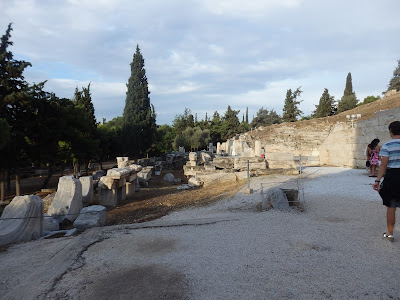
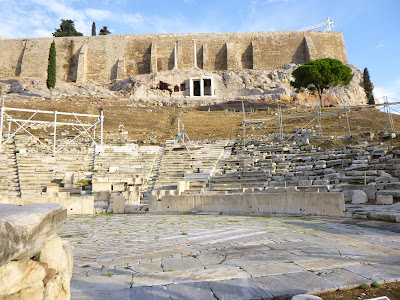






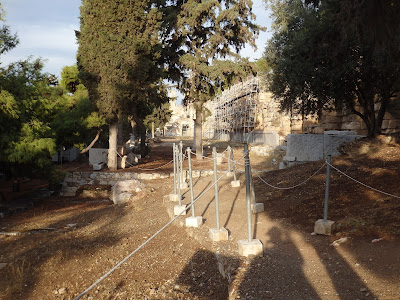














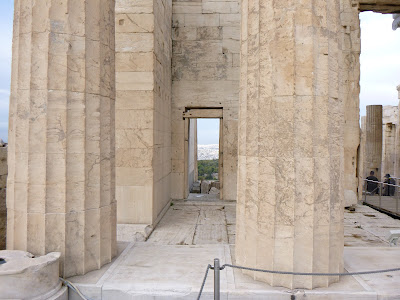










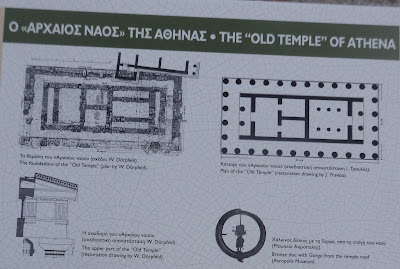






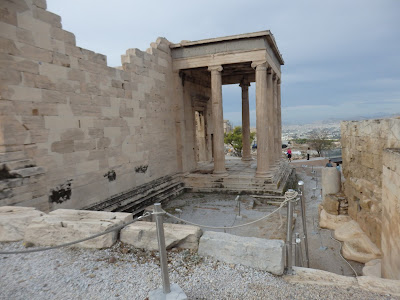






























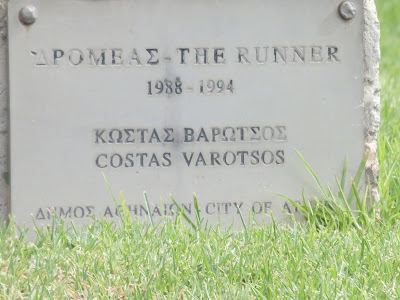

No comments:
Post a Comment